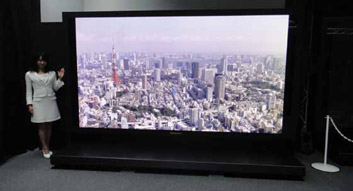Green AV: Killer Classroom App

If you’ve been watching the trade press recently, you know that Panasonic and NHK just unveiled a 145-inch ultra-high definition plasma display. One hundred and forty-five inches diagonal with no mullions! That’s roughly the size of a two-bay garage door. The resolution is 7680 x 4320 pixels (8K), detailed enough to see the brand mark on a golf ball at 20 yards.
These new jumbo displays will undoubtedly follow the usual trajectory of market adoption: trade shows and staging, then penthouse apartments, then high-end entertainment venues, then retail, then corporate boardrooms, then training and classrooms, and then seemingly overnight, your family room. At six feet high, they’re big enough to use as a display for detailed text viewing in a classroom or boardroom where the furthest viewer is 24 feet from the screen. For PowerPoint the distance becomes 36 feet, and 48 feet for general graphics viewing. In your family room, they’ll provide a near-immersive experience for gaming, sports, concerts, and movies.
And it won’t stop with plasma. LED, OLED, Quantum Dot, and other display technologies are on their way in these mega formats. You see where this is going, right? The days are numbered for the screen/projector combo, and it won’t be long before displays of this size are thin, light, touch-sensitive, flexible, and cost effective. They’ll be bright, highcontrast, and have enough detail to play Angry Birds standing up. Go ahead and scoff, but the day is not too far away when video projectors, mounts, and screens are being carted off to the recycling center by the truckload. Is that a good thing? In a word, yes.
OLED displays have a lifespan of 25,000 to 40,000 hours to half brightness versus mercury-based projection lamps with a 2,000-3,000 hour life. That’s 12 to 20 years of use at 40 hours a week versus 12 to 18 months per projection lamp. Emissive displays are bright enough to leave the shades up in many situations, so building energy controls don’t have to be overridden. LED, OLED, and QD displays use a fraction of the energy of traditional display technologies, and many of the new manufacturing processes are heavymetal free and use 100-percent recyclable materials. You will finally be able to specify a complete large classroom AV system that’s almost entirely Energy Star compliant.

Panasonic and NHK recently unveiled a 145-inch ultra-high-definition plasma display.
Personally, I’m looking forward to the day when a typical AV system consists of a wall-sized, wireless, high-contrast, paperthin, roll-up, 4-8k resolution, mercury and cadmium-free display, with NO local cabling, interfacing, switching, routing, or racks, consuming only 50 watts, and running sans wire on a 1TbE LAN. The idea of the presenter and audience showing up with nothing more than iPads appeals to both the tree-hugging environmentalist and the geeked-out technophile in me.
Yes, I know, we’ll still need wired AC power unless and until biological organisms can withstand enough microwave radiation to beam Scotty up, and yes, loudspeakers still need to actually move air, but that’s not the point. We humans have proven to be pretty good at stretching technology beyond its specified limits, and it’s only a matter of time before SMART Technologies, Tidebreak, Intel, Google, Apple, or maybe your company will develop a turnkey, tablet-based, WiDi, 200- inch, Ultra-Def, 3D classroom AV system, i.e. the “killer learning app” for the presentation, training, and education markets.
A daily selection of the top stories for AV integrators, resellers and consultants. Sign up below.
Brian E. Huff, LEED AP, DMC-E is an Associate Principal at Vantage Technology Consulting Group with offices in New York, NY, Philadelphia, PA, Boston, MA, and Los Angeles, CA. He is a member of the InfoComm Sustainable Technology Environments Program (STEP) committee, and served as the moderator of the ANSI / InfoComm Standard Guide for Audiovisual Systems Design and Coordination Processes committee.
